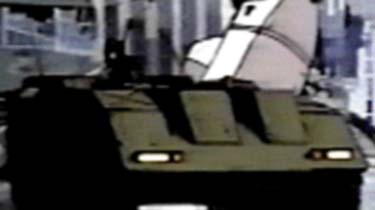

Designation: M11 Armored Security Vehicle
|

| |||||

|
||||||



The armor of the M11 and M12 is composed of an advanced titanium-steel alloy. The armor stops all small arms fire, provides good protection against heavier infantry weapons, such as a 12.7mm machinegun round, and fair resistance to light mecha-mounted weaponry, such as the Zentraedi 22.3mm HE autocannon round.
The M11 and M12 provides full protection from nuclear, biological, and chemical hazards, using an overpressure crew compartment environment activated by radiation and hazardous chemical sensors, or manually when biological warfare conditions are anticipated. The internal consumables supplies can provide atmosphere for one week maximum.
The M11 Armored Security Vehicle was initially developed by Cadillac Gage in the early 1990s to serve as a quick, maneuverable vehicle that provided limited protection for U.S. Army and Air Force Military Police. However, with the start of World War III, the U.S. Army saw a desperate need for a better reconnaissance vehicle for its light forces as the 'Humvee' had proven horribly inadequate in this role. Even more so, the Humvee's replacement for reconnaissance forces, the joint U.S./U.K. Future Scout Cavalry System / Tactical Reconnaissance Armoured Combat Equipment Requirement (TRACER), was only in the very early stages of development by the start of the war. As such, the ASV was modified with the best electronics equipment possible and hurried into wider production as the M12 Light Cavalry Vehicle. The LCV served admirably in this role, providing a highly mobile reconnaissance vehicle that could be rapidly deployed into war zones via transport aircraft or even airdropped. Capable of carrying a Mk 19 Automatic Grenade Launcher, the vehicle also provided fire support for the light armored cavalry regiment and light infantry divisions it equipped. An 'Avenger' air defense variant carrying Stinger surface-to-air missiles was proposed but never entered production.
Both the ASV and LCV were adopted by the United Nations Defense Forces. However, during the initial Zentraedi assault on Macross Island, the limitations of these vehicles were demonstrated as the Regult pods had little difficulty in rapidly destroying the units dispersed throughout the city to assist the populous in seeking the shelters.
The ASV and LCV saw a rebirth in their use after the Zentraedi Holocaust since they provided a low cost, highly mobile means to patrol wide expanses of open terrain until their retirement in 2019 with the dissolution of the UNDF and the creation of the M-120 HAV.
Return to RDF Vehicles Index
Go to Robotech Reference Guide Home Page.
Robotech (R) is the property of Harmony Gold. This document is in no way intended to infringe upon their rights.
Content by Robert Morgenstern (rmorgens@ieee.org) and Neil Baumgardner